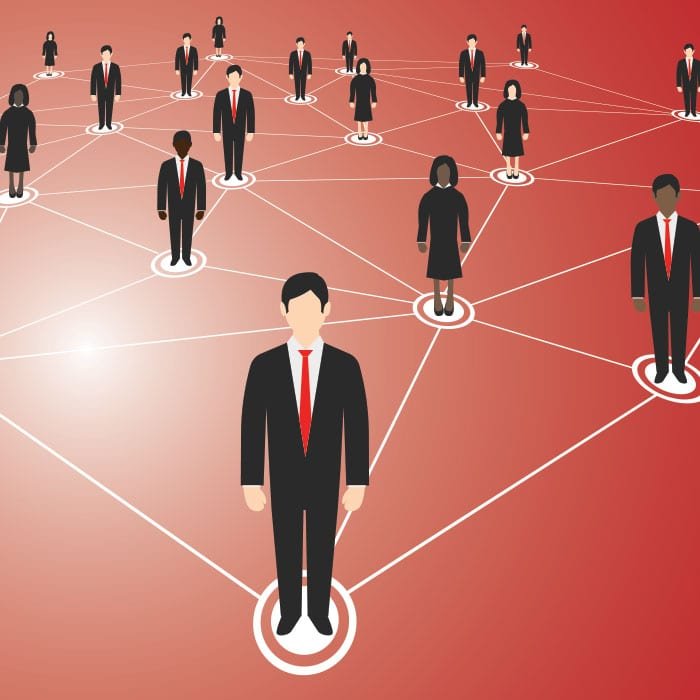Dr. Claudia Nagel, MD Nagel & Comp Leadership Consulting, President Elect ISPSO, Visiting Professor HUBS, independent NED
When working in a leadership role you have a very clear task – you give guidance, set a frame, distribute work and monitor results. You work with and for human beings, you motivate, encourage and develop them, give them respect and appreciation – in short you take care of the people you work with.
In addition, each leader carries social responsibility for the organization. For your co-workers, leaders like you represent an important human social authority. Thus – during this difficult time – entrepreneurs, CEOs and all other leaders have to make a significant contribution to social stabilization. This is crucial since pandemics on a physical level lead to pandemics on a psychosocial level.
CONTAINMENT IS KEY
First, I would like to suggest what to do and in the next step I will explain, why this is so important.
Containment is key for leaders in the actual mode of crisis. Containment provides people with the feeling of “I’m taken care of” – this is especially critical when no one knows what to do next and what the outcome of the pandemic will be. In psychology, containment refers to the interplay with another individual that helps a person to process and endure existential fears. Now, we all are exposed to these fears and have to deal with them.
“In times of fear human beings need others to feel comforted and reassured. Hence it is important that you are visible and reachable as a human being”
Dr. Claudia Nagel
The following measures can make a significant contribution to the social containment you as a leader can offer – by making yourself visible not only as a manager, but also as a representative of society and as a human being. Take into account that facing COVID 19 most people have existential fears and anxieties – whether they talk about it or not. In times of fear human beings need others to feel comforted and reassured. Hence it is important that you are visible and reachable as a human being – please don’t be afraid of being (too) close and caring (of course only virtually and from a physical distance).
1. Show yourself as a human being on YouTube, zoom or the intranet (together with members of the executive board, supervisory board and works council) and talk about your own perceptions, hopes and feelings. It is important that people not only hear your voice but that they can see you. It is not necessary to give a perfect speech, it is more like having a conversation with them.
2. It can be helpful to have a public exchange with other company leaders, for example by sharing a video conference on YouTube (or other public social media) and share what you and the company are doing and also how the business is kept up running.
3. Do not only talk about short-time work and cost reductions, but also address the emotional side of your employees, customers, suppliers, potential customers, etc.
Linked with the capability for containment is negative capability, which is the base for ambidextrous leadership. The term was coined by the poet Keats (1795-1821), who once said that “a person is capable of being in uncertainties, mysteries, doubts, without any irritable reaching after fact & reason”. French and Simpson have translated that for today’s leaders into “the capacity to sustain reflective inaction”. It is the capability to endure ambivalences and ambiguities and to work with dilemmas and paradoxes. Not to react neurotically is important – as Freud once said, Neurosis is the inability to tolerate ambiguity. This means not to jump prematurely onto a decision or into action, since anxiety and fear lead mostly to premature decision making and subsequent actions. This reflective capacity is part of self-containment. In managing your own emotions by self-awareness and self-reflection, with time and composure, difficult emotions can lose their impact and tunnel-vision can be avoided.
Ambidextrous leadership builds on negative capability and stands for a leader’s capacity to do both: to creatively explore new ideas and at the same time to exploit them with long term investments and the need for monitoring and controlling. It entails the capacity for taking “both-and”-decisions instead of “either-or”. Complex situations – and the COVID 19 Crisis is certainly extremely complex – need this kind of ambidextrous decision making.
WHY DO WE NEED CONTAINMENT AND AMBIDEXTROUS LEADERSHIP FROM YOU NOW?
A pandemic is contagious on two levels, physical and psychological, and must therefore be dealt with on two levels, through government actions and decisions, and at a socio-individual level through decision-makers from business and society.
A pandemic with a new type of virus as COVID19 that comes unprepared leads to insecurity, uncertainty and, above all, fear – on an individual and social level. We all can feel this fear and anxiety now.
The problem is that pandemics provoke powerful psychosocial processes with deep psycho- and socio-dynamic emotional effects.
These emotional effects can permanently change a society, its order and its structure.
In epidemic psychology, which Philip Strong has so coined in face of HIV and Mario Perini developed further, one speaks of three emerging psychosocial epidemic waves:
(1) an epidemic of fear,
(2) an epidemic of explanation and moralization and
(3) an epidemic of action.
These three epidemic waves usually infect an entire social system and do not stop at business leaders, governments, doctors, experts and politicians etc.
The epidemic of fear in particular can have a devastating impact and must be contained as good as possible.
Basically, there are different reactions to fear:
– It can be managed cognitively and/or emotionally if it is not too strong
or
– it is warded off by individual and social psychological defence mechanisms (individual mechanisms: resistance, denial, rationalization, postponement, forgetting, sublimation, projections and divisions, and psychosocial mechanisms: groupthink, basic assumption modes, search for scapegoats, heroes, rescuers etc.)
It becomes problematic when more or less healthy individual psychological defence mechanisms escalate into pathological forms on a social level which than are reinforced and become a problem in itself through contagion.
One of the central problems of this COVID19 pandemic is the invisibility of the virus and infection. It is not recognizable from the outside whether someone is infected or has been in contact with an infected person. The fear of being already infected is accompanied by the suspicion that the other person is already infected. Suspicion is an insidious infectious feeling and is spread and inflated through the media. A culture of suspicion then makes it possible to devalue undesirable Others, such as foreigners as well as migrants, and stigmatize them with negative projections. They easily become “plague spreaders” – this can lead to a dangerous negative spiral. Frequent travellers can also be affected by this hostility – a climate against globalization, freedom of travel and individual diversity can develop very quickly. This can also create a climate of mutual surveillance, spying on and accusing us, as we know it from dictatorships.
The fear of being infected yourself or being infected by someone else and the accompanying suspicion can also quickly deepen the contagious pandemic wave of fear. The first signs of this are the continued hamster purchases of toilet paper and food. Also, the “corona-parties” which demonstrate complete denial, are part of this contagious process.
Another problem is that the virus fuels the increasing self-victimization of people who have defined themselves as social losers. They have been calling already for (populist and self-proclaimed) heroes and rescuers – this call may deepen and attract more voices because of the economic crisis going hand-in-hand with the virus crisis.
Stigmatization, confusion and fear bring up the dark side of people so that social systems and social order and cohesion, mutual solidarity and mutual compassion are in danger in the medium term.
The answer from a psychological point of view lies in active containment- by important government members (in politics) and leadership and entrepreneurial personalities (in business) and of course also in self-containment.
In psychology, a container implies an individual who can bear and acknowledge the anxiety and fear of another person helping him/her to process and tolerate these existential feelings. This happens most impressively at the beginning of life when (mostly) the mother takes away the anxiety from the child by ingesting difficult feelings of fear from the child, i.e. through containment, absorbs them and digests them, so to speak, and returns them in small pieces. This process of projection or projective identification as well as the reintegration and integration of these feelings is part of the development of identity and awareness of the self, which always strives for coherence, continuity and integrity.
If the containment works well, the child develops the ability to self-contain. Both containment and self-containment are closely related to the ability to endure ambiguities and ambivalences and the associated feelings of stress and the fear of ignorance, without making a hasty unilateral decision or even falling apart emotionally
In general, containment plays out through a process of enduring insecurity and the following exchange and processing of feelings of fear in conversation with another person and through their warming feeling of being understood and accepted. If this other person is also a person with authority (personal or by role), this containment “works” better because it allows us to feel like a child with parents. Well intended but misplaced attempts of consolation are rather harmful, precisely because they are perceived as “wrong”. Friends and family, groups and organizations / companies can of course also act as containers.
For you as a leader, a mix of rational explanations that appeals to the adult side and an emotionally warming, caring reaction that takes care of the frightened childish side in us is important in communication. This means, on the one hand, to enable an open handling of difficult feelings, to emphasize their normality, but also the possibilities of coming through the crisis together, by helping each other. On the other hand, it also means conceiving a communication strategy with the media, appealing to their responsibility through your authority and putting an end to the constant temptation to exaggeration and psychological inflammation.
The other two emotional epidemics, explanation and moralization, and action are closely related to the first. The lack of knowledge about the virus leads to uncertainty and fear, which induces neurotic black-and-white assessments: either everything is completely harmless or the effects are incredibly devastatingly bad. Typically, there is an almost disciple-like following for both sides, which condemns the other side. Moral value judgements and decisions are an essential part of it. This development not only promotes the epidemic of fear, but also leads to the “epidemic of actions”, i.e. hastily and ill-conceived initiatives. The conflict between rational and moral judgments can eventually lead to irrationally overreaching drastic control measures to contain the disease.
In summary, it can be said that the spread of the three psycho-social epidemics can best be harnessed by containment.
I take the liberty of making this appeal to you as a leader as President Elect of ISPSO (International Society for Psychoanalytic Study of Organizations). I speak from my professional experience as economist and psychoanalyst having witnessed the effects and reactions triggered by feelings such as fear and anxiety on the corporate and social level as well as on the level of the individual.
Please stay healthy and take care of others.
Dr. Claudia Nagel


